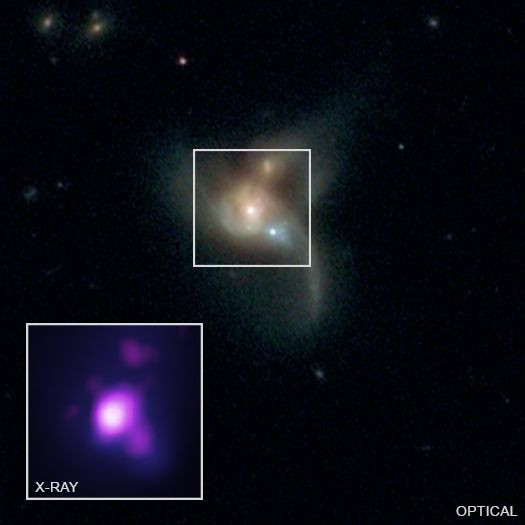NASA Photo Shows Rare 'Titanic Collision' Of Three Galaxies, Supermassive Black Holes

NASA’s Chandra X-ray Observatory was able to capture the collision of three galaxies and their black holes. Astronomers believe the collision would result in the creation of a supermassive black hole.
The system of galaxies on the verge of merging has been identified as SDSS J0849+1114. It is located about a billion light-years from Earth.
According to astronomer Ryan Pfeifle of the George Mason University in Virginia, he and his colleagues were only searching for pairs of black holes when they came across the collision within the rare system.
“We were only searching for pairs of black holes at the time, and yet, through our selection technique, we stumbled upon this amazing system,” he said in a statement. “This is the strongest evidence yet found for such a triple system of actively feeding supermassive black holes.”
Pfeifle and his colleagues’ selection technique for detecting black holes involves combining data gathered by various telescopes and observatories on Earth and in space. These include the Sloan Digital Sky Survey, a telescope based in New Mexico that uses optical light to scan the sky. The researchers also used the data gathered by NASA’s Chandra, the Wide-field Infrared Survey Explorer and the Nuclear Spectroscopic Telescope Array.
Usually, black holes are hidden by massive clouds of gas and dust, making it harder for optical telescopes and observatories to spot them. But since NASA’s observatories can be used to observe space through various wavelengths such as infrared and X-ray, the astronomers were able to see beyond the dust clouds and identify the black holes within SDSS J0849+1114.
“Through the use of these major observatories, we have identified a new way of identifying triple supermassive black holes,” Pfeifle explained. “Each telescope gives us a different clue about what’s going on in these systems.”
“We hope to extend our work to find more triples using the same technique,” he added.
According to astronomers, three black holes that are about to merge behave differently compared to pairs. The merger of the triplets tends to happen much faster than a collision between two black holes. This is mainly because the third black hole can provide the additional gravitational force that can pull the other two together.
© Copyright IBTimes 2025. All rights reserved.





















